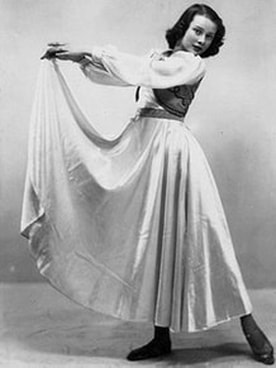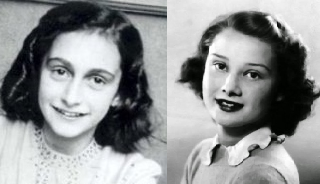|
One of the things that fascinates me is the discovery of historical details and connections that add layers of meaning to our understanding, and to the stories we tell about the past. Recently, I learned of the threads that connect Audrey Hepburn and Anne Frank. The girls were born within one month of each other in 1929, Anne in Germany and Audrey in Belgium. Audrey lived with her English-Austrian father in England for several years, but by the time the war broke out, both girls had moved to the Netherlands, where they ended up living just miles apart. After Nazi Germany invaded Holland in the spring of 1940, Jewish Anne Frank would become known to the world for the diary she wrote while hiding for her life. She would die in a Nazi death camp. Audrey Hepburn's parents supported Adolf Hitler, her father an agent for the Nazi regime, her mother an admirer of the Fuhrer. But Audrey joined the resistance and suffered near starvation under German occupation resulting in her often-admired slender figure, famous in the movies Roman Holiday and Breakfast at Tiffany's. At the end of World War II and the Netherlands' Hunger Winter, Audrey, aged sixteen, stood five foot six, but weighed only 88-pounds. She was one of the first to read Anne Frank's diary, but asked to play in a movie based on Diary of a Young Girl, Audrey declined the role, saying it was too painful. Her son Luca Dotti told People Magazine his mother knew passages of Anne Frank's diary by heart. “My mother never accepted the simple fact that she got luckier than Anne. She possibly hated herself for that twist of fate.” Audrey Hepburn's British-Austrian father and Dutch Baroness mother both held fascist sympathies in the 1930s. Ella van Heemstra had a private meeting with Adolf Hitler, where, to the Baroness's bliss, the Nazi leader kissed her hand.  Audrey Hepburn and her mother Ella Van Heemstra Audrey Hepburn and her mother Ella Van Heemstra Audrey's father left the family before the war, and apparently in 1942, her mother had a change of heart about Hitler after the Nazis executed her sister's husband. Otto van Limburg Stirum was arrested in retaliation for sabotage by the resistance movement. He and four others were driven to a forest, made to dig their own graves and then shot. Before that, the realities of the war had come gradually to Audrey. “The first few months we didn’t know quite what had happened … I just went to school,” Hepburn said. “In the schools, the children learned their lessons in arithmetic with problems like this: ‘If 1,000 English bombers attack Berlin and 900 are shot down, how many will return to England?’"  Audrey had started to learn ballet as a young girl in England, and as conditions became strained and dangerous, she turned back to dance to relieve the pressure of Nazi rule. "When I would go to the station, there were cattle cars packed with Jewish families, with old people and children,” Hepburn once said. “We did not yet know that they were traveling to their deaths. People said they were going to the ‘countryside.’ It was very difficult to understand, for I was a child. All the nightmares of my life are mixed in with those images.” A quiet, withdrawn child, Audey bloomed on the stage and soon began to perform at illegal events in hidden venues with the windows blacked out. These by-invitation-only zwarte avonden, black evenings, raised money for the Dutch Resistance. “Guards were posted outside to let us know when Germans approached,” Hepburn would later say. “The best audiences I ever had made not a single sound at the end of my performance.” Audrey Hepburn Aides Nazi Resistance Audrey also helped deliver tiny-sized copies of a resistance newspaper, Oranjekrant. “I stuffed them in my woolen socks in my wooden shoes, got on my bike and delivered them.” As a teenager, she avoided the suspicions of police and was also able to carry messages and food to Allied pilots shot down over the Netherlands in 1944. Though Audrey's mother had been known as a lipstick Nazi for being friendly with German soldiers early in the war, she sheltered an English pilot in their home. Luca Dotti wrote that it was a thrilling experience for Audrey. "It was risky, he was a stranger in uniform, a savior, and therefore a knight and hero. [But] if you were caught hiding an enemy, the whole family would be taken away.” Dutch people in the countryside felt the deprivations of war acutely in the winter of 1944-45, later known as Hongerwinter, Hunger Winter. Families went without heat and electricity and food grew scarce. Audrey sometimes didn't eat for as long as three days, and sometimes subsisted on bread made from brown beans and potatoes. According to Hepburn's son, “Twenty two thousand people died from hunger in Holland during the final months of World War II, my mother escaping death by a hairbreadth.” Audrey's town was finally liberated by Allied troops in spring 1945.  Throughout her life, Audrey Hepburn spoke very little about the war years, some say out of fear that her parents' Nazi sympathies might harm her acting career. A good number of books have told the story of Audrey Hepburn's movie star career, jet-setting life and generosity as an ambassador for UNICEF. But a new biography out this month focuses specifically on her life during World War II. I wrote about new evidence concerning the arrest of Anne Frank's family here... Sources: Audrey at Home, Memories of Mother's Kitchen by Luca Dotti https://infosurhoy.com/cocoon/saii/xhtml/en_GB/news/how-audrey-hepburn-feared-her-moms-admiration-of-adolf-hitler-would-break-her-profession/ https://forward.com/schmooze/422225/why-audrey-hepburn-refused-to-play-her-soul-sister-anne-frank/ https://people.com/celebrity/audrey-hepburns-personal-connection-to-anne-frank/ Comments are closed.
|
I'm fascinated to discover little-known history, stories of people and events that provide a new perspective on why and how things happened, new voices that haven't been heard, insight into how the past brought us here today, and how it might guide us to a better future.
I also post here about my books and feature other authors and their books on compelling and important historical topics. Occasionally, I share what makes me happy, pictures of my garden, recipes I've made, events I've attended, people I've met. I'm always happy to hear from readers in the blog comments, by email or social media. Archives
September 2023
Categories
All
|



